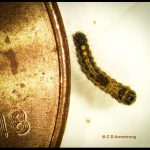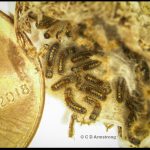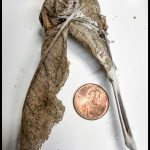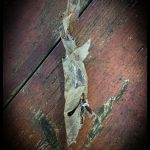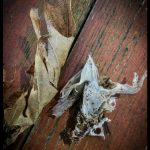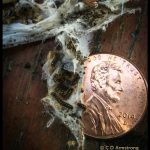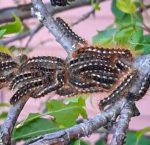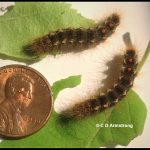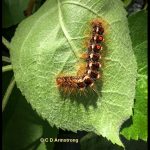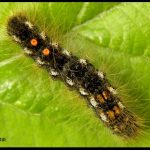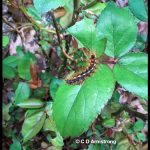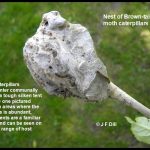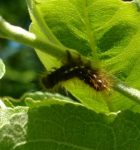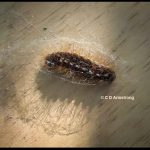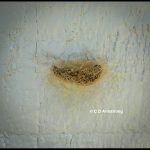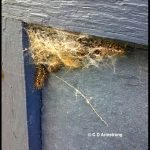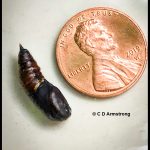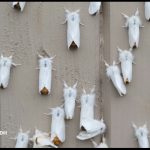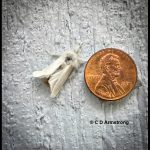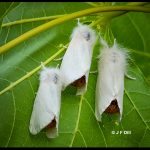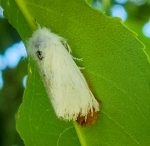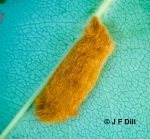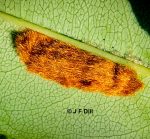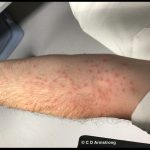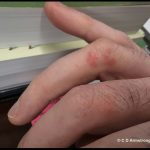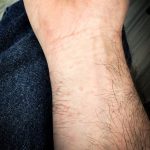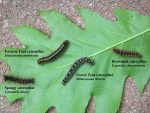Browntail Moth (more photos below)

The Browntail Moth (Euproctis chrysorrhoea) was accidentally brought to Massachusetts from its native Europe in 1897, and soon after spread to the rest of New England and also moved into New Brunswick and Nova Scotia. The caterpillars have a huge host range of plants that they feed upon. However, they especially love oak, birch, apple, crabapple, pear, peaches, plums and cherry trees. In addition to other hardwoods, they’ll also devour rose bushes that they encounter in the landscape after being dislodged from their primary host trees due to wind or other disturbances. Since apples, cherries, peaches, pears, and plums are all members of the rose family (Rosaceae), it’s not terribly surprising that they will also readily feed on rose leaves as well. UMaine researchers also recently discovered that at least the later-instar caterpillars can also survive on conifers.
A major problem with this insect stems from the fact that the caterpillars and cocoons are armed with defensive, microscopic barbed hairs which can travel through the air and–for many people exposed to them—cause skin rashes, headaches, and sometimes breathing difficulties. The reactions on the skin can mimic insect bites in appearance and sensation (often with extreme and long-lasting itchiness), causing many people to frequently mistake them as signs of mite, flea, or bed bug infestations, especially when they wake up in the morning to discover several brand new welts on any number of seemingly random locations on their body. Further complicating the situation is the fact that the toxin in the hairs can remain viable for upwards of three years as long as the hairs remain dry and out of the elements. Also, the caterpillars use their hairs in the construction of their cocoons, which are often formed in protective places around window and door frames, under the overhangs of rooftops, under eaves/gutters, inside garages that have been left open, etc. Thus, encounters with fresh or even long-since empty cocoons will typically result in additional exposures to the hairs.
The moths are attracted to light, fly at night, and are active in July and August. They have a wingspread of about 1.5 inches (36-42 mm). The wings and midsection are solid white on both the male and the female. The abdomen has brown on it, and the brown coloration extends along most of the upper surface of the abdomen in the male [male example], whereas in the female, the top (upper/dorsal surface) of the abdomen is white, but the tuft of brown hairs at the very end is considerably thicker/wider compared to the male [female example]. Fortunately, the hairs on the adult moths are not toxic so those hairs do not cause a skin rash.
Browntail Moth (Adult Stage) Potential Lookalikes:
-
- Fall Webworm Moth (sometimes) — Populations found in Maine and other northern portions of its range have wings that are sometimes solid white instead of having brown spots and patches all over them (Spotted Form of Fall Webworm); adults appear in Maine earlier than Browntail Moth (end of May and early June as opposed to July, respectively) (BugGuide.net)
- Virginian Tiger Moth — A similar white moth sometimes occurring at the same time in Maine as the browntail moth (but starts about a month earlier) but with one or sometimes two distinctive black dots near the base of each hindwing, and only a small amount of brown, if any, on the underside of the abdomen) (BugGuide.net)
Photos and Additional Information:
- Browntail Moth – Information and Updates (Maine Forest Service) (includes a video on removing browntail caterpillar nests)
- YouTube Video: Browntail Moth Detection in Maine (Maine Forest Service) — Includes information about browntail moth overwintering webs, tips for identification and instructions for removal and destruction of webs within reach from the ground.
- Frequently Asked Questions (FAQs) about Browntail Moth (Maine Department of ACF)
- Take part in a Browntail Moth Research Survey (Maine Forest Service)
- Maps of Winter Web Surveys and Exposure Risk (Maine Forest Service):
- Management Resources:
- Licensed Pesticide Applicators Willing to Treat Trees for Browntail Moth [pdf] (Maine Forest Service – 2022)
- List of Licensed Arborists Willing to Prune Browntail Moth Nests (pdf) (List provided by the Maine Department of ACF)
- In the News:
- Maine Forest Service Update (3/21/2025)
- Browntail moth caterpillars can feed on conifers during outbreaks, UMaine researchers discover (June 14, 2022)
- Mech interviewed by BDN about impending browntail moth season (May 12, 2022)
- UMaine research connects rising temperatures with browntail moth resurgence (Feb. 17, 2022)
- Notes to Consider:
- Many people confuse the nests and caterpillars of Fall Webworm with those of the browntail. Nests containing Fall webworm caterpillars are quite large and can be seen throughout August and September in a wide variety of hardwood trees.
- February is an ideal time to remove their nests — See also: Using Aerial Drones in an Innovative Way to Remove Browntail Moth Nests (YouTube video) — This technology is now being used by Mann’s Lumber & Tree (Litchfield, Maine) and also–if you are in Kennebec County or the Belgrade Lakes region: Aerial Browntail Clipping
- Early-instar Browntail caterpillar (Orono, ME; 9/17/2021) (the dark area just behind the head is where the microscopic toxic hairs are produced)
- A peek inside a winter nest of Browntail caterpillars with roughly 30 healthy individuals (Orono, ME; 3/14/2022)
- A typical overwintering nest of immature Browntail caterpillars formed at the end of a crabapple branch (the nest was home to approximately 30 healthy, early-instar browntail caterpillars as seen in the adjacent photo) (Orono, ME; 3/14/2022)
- An oak leaf produced in 2021 found on the ground on April 24th, 2022 with signs of a likely cluster of browntail caterpillars inside of it (its contents are revealed in the two adjacent photos) (Etna, Maine)
- Oak leaf with its package of webbing removed for a closer examination (see adjacent photo–with a penny included–to see its contents)
- A cluster of young browntail caterpillars exposed from their protective nest of webbing that was removed from an oak leaf produced in 2021 that had fallen to the ground (April 24th, 2022; Etna, Maine)
- Browntail Caterpillars on a crabapple tree in Waterville, Maine; 5/12/2021 (Photo courtesy of Jamie Graves)
- Browntail Moth (late-instar caterpillars feeding on wild apple leaves; Lincolnville Center, ME – 6/5/2019)
- Browntail Moth (late instar caterpillar on a wild apple leaf; Lincolnville Center, ME – 6/5/2019)
- Browntail Moth (late instar caterpillar stage)
- Browntail caterpillar (Euproctis chrysorrhoea) feeding on a rosebush (plants in the Rosaceae family are a favorite of theirs) (Etna, ME; 5/25/2022)
- Browntail Moth (example of a spring/early summer-season nest)
- Browntail Moth caterpillar infected with E. aulicae fungus at Lake St. George Park in Liberty, ME. (Photo courtesy of Tom Schmeelk, Maine Forest Service)
- A browntail caterpillar beginning to form its cocoon on the side of a house (Etna, ME; 6/10/2022)
- Early stage of a browntail caterpillar’s cocoon (Etna, ME; 6/12/2022); Hairs from the caterpillar go into the construction of the cocoon so cocoons pose a threat as well with regards to their rash-inducing potential.
- A cluster of browntail caterpillars on a garage door in the early stages of their cocoon formation/construction (Etna, ME; 6/10/2022)
- Pupa of a Browntail Moth extracted from its hairy cocoon for photo purposes (Etna, ME; 6/15/2021)
- Browntail Moths in Kennebec County (7/1/2021)
- Closer view of some Browntail Moths from the adjacent photo (Kennebec County, Maine, 7/1/2021)
- Browntail Moth (Etna, ME; 6/28/2021)
- Browntail Moths; note the brown ‘tail’ at the end of the abdomen (Kennebec County, Maine, 7/1/2021)
- Female Browntail Moth depositing her mass of eggs (Old Town, ME; 7/10/2022)
- Egg mass from a Browntail Moth (Old Town, ME; 7/11/2022)
- Egg mass from a Browntail Moth (Old Town, ME; 7/11/2022)
- An example of a bad case of the skin rash that the hairs from the browntail caterpillars–and later on their cocoons–can cause. Staff Photo, taken 5/26/21.
- Example of a typical reaction to the Browntail caterpillar hairs on a person’s arm. July 12th, 2021.
- Example of an unfortunate reaction to the Browntail caterpillar hairs on a person’s fingers. May 23rd, 2022.
- Example of the early stage of a milder case of a reaction to the Browntail caterpillar hairs on a person’s wrist. Staff Photo (5/26/2021).
- Comparison of four different caterpillar species in Maine that are sometimes difficult for people to differentiate, and oak is one of the hosts they all have in common (Photographed: central Maine; 6/12/2022) (Eastern Tent caterpillar, Spongy caterpillar, Forest Tent caterpillar, and the Browntail caterpillar)

